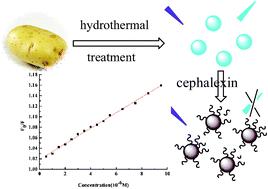One-step synthesis of carbon nanodots for sensitive detection of cephalexin
Abstract
Blue photoluminescence water soluble carbon dots with an average size of 1.5 nm were synthesized by hydrothermal treatment of fresh potato at 200 °C for 5 h without adding any other reagents. XRD and TEM illustrated the poor crystalline nature and narrow distribution of these spherical carbon dots. The functional groups were confirmed by FTIR studies. Thus bio-based photoluminescence carbon dots were applied to the detection of cephalexin. The sensing probe exhibits many advantages, such as wide linear response range, high sensitivity and short response time with a detection limit as low as 0.311 μM.


 Please wait while we load your content...
Please wait while we load your content...